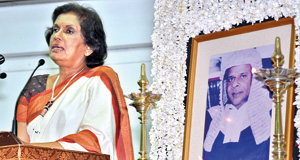President Chandrika Bandaranaike Kumaratunga always wrote well and spoke eloquently when she resisted a propensity to be overly loquacious. While her recent peroration contains many intelligent and valid points, her credibility and their validity comes into serious question because she is not an independent observer or a reformist leader –in-waiting, but precisely a two term president who won by record majorities, and was indeed the immediate predecessor of the present incumbent. Most ironic is the fact that many of the ills she identifies or attributes to present day Sri Lanka stem directly from her political sins of omission and commission. What is conspicuously lacking in her discourse is any sign of reflexivity; of self-criticism.
 |
| Chandrika Bandaranaike Kumaratunga |
My criticism pertains to four vital spheres (including those of her current concern), namely viable devolution, a less discriminatory society, the role of radical Sinhala nationalism/ultra-nationalism and of course defeating terrorism and reunifying the Sri Lankan state.
Having been elected by an unprecedented majority, CBK could have easily pushed through reforms making for moderate power-sharing if she had activated one of five options feasible at the time: the 13th Amendment, the Mangala Moonesinghe Select Committee Report (to which one of the signatories was her mother, Madam Sirimavo Bandaranaike), the Bandaranaike-Chelvanayagam Pact, promulgate an Interim Administration as per the 13th Amendment or improve modestly on the 13th Amendment through majorities in the provincial councils. She did none of these. Instead she headed off on a wild goose chase of an overly ambitious ‘union of regions’ package. And having done so, what is her credibility and ethical standing in criticising the government of the day?
CBK is concerned about a more inclusive, non-discriminatory society. I believe this to be sincere. However why did she not move in this direction by implementing her own Equal Opportunities Bill? Why did she withdraw it? Having done so, what is the credibility of her contemporary social critique? President Kumaratunga laments the role of the Sinhala hawks. Fair enough, but who empowered them? By picking Justice Sarath N Silva over Justice Mark Fernando, CBK surely helped tilt the balance.
During the dark days of appeasement under the CFA, I was invited by her as the main discussant at a meeting of the SLFP parliamentary group, held at the President’s Pavilion in Kandy and chaired by her. I articulated the perspective that a united front of the centre-Left with the JVP was necessary but that the centrist SLFP must be firmly hegemonic and that the JVP really had nowhere else to go. I also recall Mahinda Rajapaksa as being most critical and pessimistic about a bloc with the JVP. In the event the SLFP under President Kumaratunga’s leadership conceded a massive slice of forty seats to the JVP!
It is this parliamentary bloc that President Rajapaksa inherited and had to keep together while fighting the war. It is precisely the JVP that threatened to withdraw or actually withdrew from the APRC after its Experts Committee which had produced a constructive report on devolution. Apprehensive that his parliamentary majority may be in jeopardy, the President hit the brakes on the entire exercise.
Sinhala extremism was re-legitimised by her insistence that Vijaya Kumaratunga had been killed by Premadasa, rather than the JVP and the JVP alone. It fed off her erroneous choice of a peace mediator, at the wrong time too. She chose Norway, with its strong Tamil lobby, and did so in the late 1990s when the Sri Lankan military could have gone on the counter offensive , and persevered with the ‘ peace process’ after the assassination attempt on her and the events of 9/11, which taken together would have provided her the external conditions to smash the Tigers.
She crippled her own military’s capacity to go for the kill by continuing with the Sudu Nelum movement, an anti-war movement which could and did conduct its campaign only in the Sinhala majority areas, thereby cutting into recruitment for the military in such a manner that it could not hold the territory it liberated and go onto liberate more. Southern extremism and fundamentalism were fuelled by the Sudu Nelum phenomenon and the role of Norway, both CBK inputs.
The Sinhala ultras received a major, if unintended contribution from President Kumaratunga in the shape of her PTOMS proposals, which were challenged by the JVP and frozen by the Supreme Court—and quite rightly too, as its crucial middle tier gave the Sri Lankan state 3 slots and the LTTE 5!
As to the core issues of defeating terrorism and reuniting the territory of Sri Lanka, President Kumaratunga made some signal contributions but failed to capitalise on them and went onto partially reverse some of them. She could have continued the offensive following the admirable liberation of Jaffna by her, and her no less admirable defence of Jaffna in year 2000. Yet, she did not. Furthermore, at the time of the strategically critical Karuna split, she permitted Prabhakaran’s forces to make a sea-borne landing in his rear area, passing through Sri Lankan navy lines.
Sartre once said that what matters is not what is done to us but what we do with what is done to us. Mahinda Rajapaksa inherited a divided territory and a military whose spirit was debilitated. With these, he achieved that which no leader achieved for three decades. He defeated the Tigers, reunited the island’s territory and reopened the electoral political space for the revival of democratic Tamil politics including Tamil nationalist politics.
The writer is Sri Lanka's Ambassador to France |


